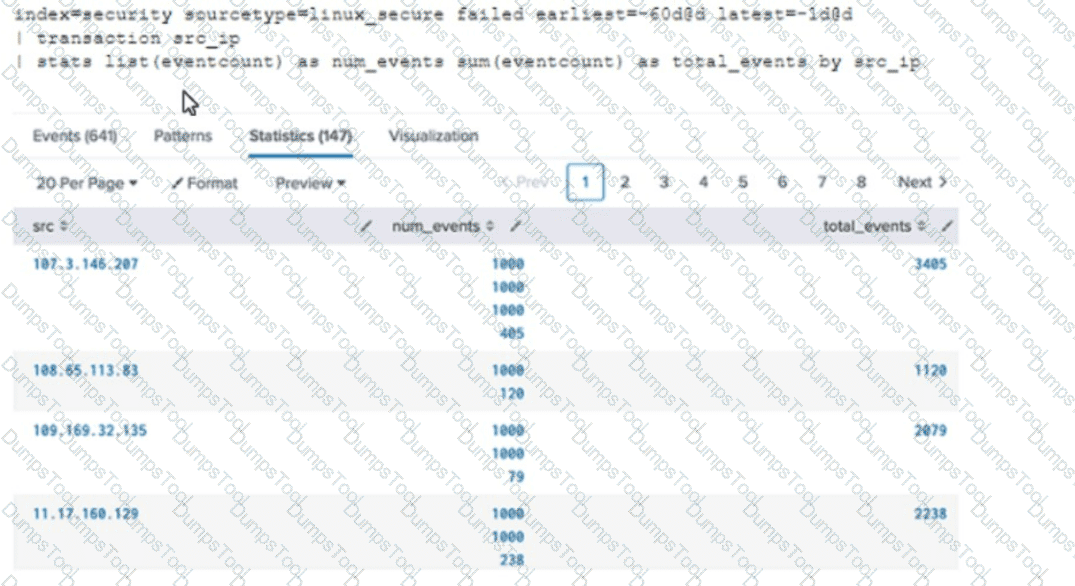Which type of visualization shows relationships between discrete values in three dimensions?
Which of the following transforming commands can be used with transactions?
To create a tag, which of the following conditions must be met by the user?
What functionality does the Splunk Common Information Model (CIM) rely on to normalize fields with different names?
When should the regular expression mode of Field Extractor (FX) be used? (select all that apply)
When creating a search workflow action, what character(s) are used as a placeholder for field values in the search string?
Which of the following describes this search?
New Search
'third_party_outages(EMEA,-24h)'
Consider the the following search run over a time range of last 7 days:
index=web sourcetype=access_conbined | timechart avg(bytes) by product_nane
Which option is used to change the default time span so that results are grouped into 12 hour intervals?
What syntax would a user specify to search for the prod tag associated with the host field and webserver value?
Which search string would only return results for an event type called success ful_purchases?
Which of the following statements describe data model acceleration? (select all that apply)
For the following search, which command would further filter for only IP addresses present more than five times?
Which field will be used to populate the field if the productName and product:d fields have values for a given event?
| eval productINFO=coalesco(productName,productid)
Which of the following statements about event types is true? (select all that apply)
The time range specified for a historical search defines the ____________ .------questionable on ans
If there are fields in the data with values that are " " or empty but not null, which of the following would add a value?
Which of the following statements would help a user choose between the transaction and stats commands?
Which command can include both an over and a by clause to divide results into sub-groupings?
Which of the following data model are included In the Splunk Common Information Model (CIM) add-on? (select all that apply)
When using the timechart command, how can a user group the events into buckets based on time?
When using the transaction command, how are evicted transactions identified?
Which of the following is one of the pre-configured data models included in the Splunk Common Information Model (CIM) add-on?
When using a field value variable with a Workflow Action, which punctuation mark will escape the data
The transaction command allows you to __________ events across multiple sources
Which of the following definitions describes a macro named “samplemacro” that accepts two arguments?
When would a user select delimited field extractions using the Field Extractor (FX)?
Why would the following search produce multiple transactions instead of one?

__________ datasets can be added to root dataset to narrow down the search
Which of the following searches will return events contains a tag name Privileged?
This function of the stats command allows you to return the middle-most value of field X.
Data model are composed of one or more of which of the following datasets? (select all that apply.)
Given the event below, how can the value in the Zip_Code field be used to retrieve the weather from an external resource?
25/Oct/2023:20:29:43
151.162.101.143, v2.003, Zip_Code: 75510, DataCenter: DC1
Which of the following statements describe the search string below?
| datamodel Application_State All_Application_State search
To identify all of the contributing events within a transaction that contains at least one REJECT event, which syntax is correct?
Which of the following is included with the Common Information Model (CIM) add-on?
This function of the stats command allows you to identify the number of values a field has.
Which of the following search control will not re-rerun the search? (Select all that apply.)
Information needed to create a GET workflow action includes which of the following? (select all that apply.)
A macro has another macro nested within it, and this inner macro requires an argument. How can the user pass this argument into the SPL?
Which of the following searches would create a graph similar to the one below?

There are several ways to access the field extractor. Which option automatically identifies data type, source type, and sample event?
Which of the following options should a user add to a search to limit transactions to a five minute time window?
What is a benefit of installing the Splunk Common Information Model (CIM) add-on?
Which type of workflow action sends field values to an external resource (e.g. a ticketing system)?
Data models are composed of one or more of which of the following datasets? (select all that apply)
Splunk alerts can be based on search that run______. (Select all that apply.)
A POST workflow action will pass which types of arguments to an external website?
Which of the following statements describes the use of the Filed Extractor (FX)?
The Field Extractor (FX) is used to extract a custom field. A report can be created using this custom field. The created report can then be shared with other people in the organization. If another person in the organization runs the shared report and no results are returned, why might this be? (select all that apply)
Consider the following search:
Index=web sourcetype=access_combined
The log shows several events that share the same JSESSIONID value (SD404K289O2F151). View the events as a group. From the following list, which search groups events by JSESSIONID?